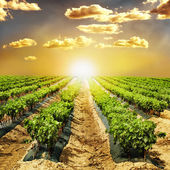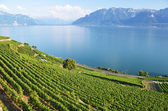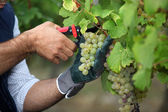Introduction
The origin of all wine is in the vineyard, where vines are grown until they hold grapes. Without vines and grapes there can be no question of wine making. Except during the winter months, when grape vines are dormant, a vineyard is a place of extraordinary activity. Workers provide daily care to the growing grapes, apply fertilizers or chemical sprays as needed and check the grapes for problems or the presence of moulds or pests.
We can nowadays positively affect the quality of wine using all kinds of technical resources, but there will still be the natural conditions in the vineyard that partly determine its character, such as soil, climate, location, summarized as terroir. You will find a more detailed article on terroir here. These are circumstances that every vineyard will have to deal with in one way or another, but cannot be influenced much, if at all, by humans. In the next paragraphs I will explain what a vineyard is and how humans with their methods of operation can indeed influence the quality of the wine.
Vineyard plantings
It is the way in which vineyards do their planting that is of influence on the total of conditions which affect the growth of the vine. From its origins the wild grapevine is a creeping plant that remains on the ground with its spurs or it wound itself around trees. When they began to use the plant for wine, they had to look for ways to grow the grapes above the ground to prevent rot among other things. One of the earliest solutions was to develop a wine plant that wound it selves around trees exactly like it happened in the wild. In later times they planted vines in an arranged way, such as in rows and with a deliberately planned number of plants per plot.
The plant density is a quality factor that cannot to be underestimated. In hot, dry regions you historically had low density, because the vines had to share the little water available. A high density caused competition between the vines. The number of plants per 2.5 acres can vary widely, from less than 3,000 to more than 10,000!
Leaf growth for the grape plant is just as important as the formation of clusters. It is after all through the leaves, that photosynthesis from the sun light, the conversion of carbonic acid and sugar in water and oxygen, takes place.
Terraces
 The most evocative example of human influence on the terroir is the construction of terraces on steep slopes. You see that kind of planting especially in river valleys.
The most evocative example of human influence on the terroir is the construction of terraces on steep slopes. You see that kind of planting especially in river valleys.
There are other things that play a role in soil, such as soil preparation and the way in which weeds, plant diseases and fungi are fought. Terroir does indeed benefit from a ‘living’ vineyard which has both an underground and above ground habitat for all kinds of organisms and animals. Should they use synthetic agents or work properly with greening by sowing herbs between the rows of vines? You spray on a fixed schedule, or only when it is inevitable? How do you take care of the fertilization? These are questions to which the answer has a great effect on the health of the grapes. Vineyards have the responsibility to decide and respond to all these aspects.
Irrigation
Another form of human intervention is the use of irrigation. Especially in wine countries outside Europe it is necessary because it is often too dry there. Within Europe, irrigation is needed less frequently. In some countries watering is even prohibited or is only allowed under complex rules.
The art of irrigation is to provide help to the vine in moderation. Too much water would grow ‘lazy’ roots”, but well-dosed water prevents drought stress during which growth and maturation come to a complete stop. The most common form of irrigation is when working with a computer-controlled drip system, the so-called drip irrigation.
In some wine areas, in the spring, there is a reasonable chance of frost, against which various means are used to prevent the adverse effects of it. Sometimes vineyards use large fans to keep the air moving, or stoves or by spraying the fragile buds with water. When they freeze over, the buds themselves will be spared.
Guiding and pruning
In viticulture quantity is at odds with quality. It is therefore important that a vintner keeps its produce within limits. The vine has a natural tendency to grow exuberantly. Unrestrained growth, however, results in fruit with insufficient extract and sugars and even in wine where there is not much taste at all.
One of the means to hold the yield in check is guiding and pruning of the vine. The guiding occurs mostly along horizontally strung wires. By pruning, the winegrower can already determine in advance how much fruit the vine will produce, weather permitting. To minimize risks, you can prune so that there is some slack to absorb the impact of bad weather or illness in the spring. If no disasters happen and the growth appears to be abundant, then you can always perform a green harvest, which means that bunches deemed redundant and not ripening would be removed. In this way, the plant can concentrate its energy on the maturation of the remaining bunches.
Vinification (conversion of grape juice to wine)
The harvest of the grapes is done entirely by hand, so the grapes can be obtained as intact as possible. It also offers the possibility to start selecting at the very vine. At this point a vineyard may sell their grapes to a winery for further processing, but a lot of them will still have the in-house capabilities to complete the process.
The moment of compression is one of the largest differences between the preparation of white and red wine. Grapes destined for white wines, in which no colour from the peel of the grape has to be diverted will be pressed before the start of the fermentation. Grapes for red wine, or rather the remains thereof, shall be pressed only after the alcoholic fermentation. For the grapes in the press or the fermenting container will need to be defoliated and fully or partly stemmed. This is done to avoid unpleasant, bitter unwanted flavours. For the same reason, it is important to press the grapes as softly as possible and to avoid damaging the seeds.
The fermentation is the essence of wine making. The sugars by yeast cells are converted into alcohol and carbon dioxide mainly. The winemaker usually adds its own yeast cells to the must, because the natural yeast cells that sit on the grape skins are sometimes “wild” yeast cells. They may interfere with the fermentation process. Biological and bio dynamic winemakers try as much as possible to work with the cells of the yeast’s own, or with a grape type of yeast cells which is inherent in the environment where the grapes are growing, for a more authentic flavour.
When the fermentation process is finished the wine can be bottled. Some wines would be drinkable already, but most of them will need to age more in the bottles.
Conclusion
Here we could see again how delicate grapes are and how sensitive to all treatments, hence the importance of vineyards and wineries. By the way they handle the grapes, the harvesting, the fermentation process and what they possibly add, they can greatly influence the quality of their wines.
This site is for wine lovers and if you are a Chardonnay fan even better, you will have access to the best. I am in search of the best Chardonnays worldwide and already found a lot of them. I have reviewed and rated them and you can see the list of reviews by clicking the three images to the right (for mobile users just under the text) under the heading world best Chardonnays. Chose the area that you are in for the right delivery location.
Thank you for your interest and consideration and if you have any comments, feel free to do so. I will attend to your comments and or questions within 24 hours.
